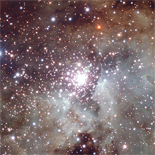Astronomy 352K - Fall 2010
STELLAR ASTRONOMY
MWF 9-10 · RLM 15.216B · Unique No. 47725

NGC 3603 (ESO)
Professor
RLM 17.206 · TBA · (512) 471-1349 · email
Courses - Fall '10 | Course Website
Homework, and your approach to it? The homework sets are the keys to what I want to get done in this course. I intend to be deliberately vague in some of the assignments. I admit that this is a sometimes maddening ploy. Real astronomical research usually does not admit cookbook solutions to interesting problems, and I want you to get used to that. Such an approach is also a signal on my part that I encourage interactions with you outside class. Feel free to discuss with me the course material, problem sets, or any other astronomical topic that come to mind. On the first page I give the formal office hours, but you of course may set up appointments with me at other rational times of day. Notice also that I give my work number, email address, and my home phone number. I greatly prefer contact in person or a phone call; emails to me can get deeply buried. I would not give out my home phone number if I did not expect calls in the evening whenever you need to. (It is true that we are the only Snedens in the Austin telephone directory.) I want to help you do well in this course, but I need you to make contact! Don't be shy: remember that the truly stupid question is the unasked one.
Caveat Emptor! Two warnings must be given, one applicable to all faculty members here and one specific to me. First, in this department you deal with professional astronomers. The good part is that you get very close to current research, and that can be very exciting. The bad part is that we tend to travel a lot (most obviously to observatories in remote and exotic locales), and I will need to excuse myself from class a couple of times during the semester. At present I have a trip for November 2-7 (missing class November 2 maybe & 4 definitely); one or two other trips that are unknown now might occur. A substitute lecturer will pinch-hit for me in class on those occasions. All class meetings will occur as scheduled. Second, I am currently Letters Editor of The Astrophysical Journal. This means that inevitably I am pulled in many different teaching/service/research directions simultaneously, and frankly I am very busy. However, this should not become your problem! I expect you to work in this class, and you should expect no less of me. Do not feel the slightest hesitation in pushing me to make time for you outside of class; politely in the beginning, but more firmly if I do not respond. Your interaction in this course can only aid your understanding.
Finally, a Carrot Instead of a Stick: I formally teach only one semester each year (because of my editing duties). In spring 2011 (an "off" semester) I will be offering a guided research position to an interested student who has successfully (A-B grade) completed AST 352K this semester. Usually the student will sign up for some course number that signifies independent study. Real investigation into the chemical composition of stars will occur! Some background buildup will be necessary, but then collaborative research can commence. A grade for that course will be the least interesting outcome, as successful work (often going beyond the spring semester) should lead to a published paper and/or attendance at a professional meeting.
Preliminary Course Outline (subject to revision)
Introduction and Vital Observational Statistics of Stars: positions, distances, magni- tudes, etc.
The Basic Quantities of Radiation: intensity, flux, blackbodies
Interpreting Stellar Magnitudes: luminosity & effective temperature; stellar photometry & color indices; effects of the Earth's atmosphere
The Heart of Observational Stellar Physics: spectroscopy; stellar spectral types; exci- tation & ionization equilibria; the Hertzsprung-Russell diagram
Further Extractions from Spectroscopy: radial velocity & proper motion; interstellar extinction; binary stars & the measurement of stellar masses; the Mass-Luminosity relation
Variable Stars: Cepheids, RR Lyraes, Long-Period Variables; white dwarf pulsators; close binary systems (mass-exchange & contact binaries; cataclysmic variables; novae; etc.)
Star Clusters: young clusters/pre-MS evolution; Main Sequence turnoffs & cluster ages; globular clusters; etc.
(as time permits) Stellar Atmospheres: radiative transfer; basic principles of model atmospheres; spectral lines & abundance determinations.
Your First Assignment
Please read the first chapter of the text in enough "detail" to be able to
come to class on the second day with questions. In particular, note
carefully how this chapter matches (haphazardly) with the course
material order of presentation in the notes.